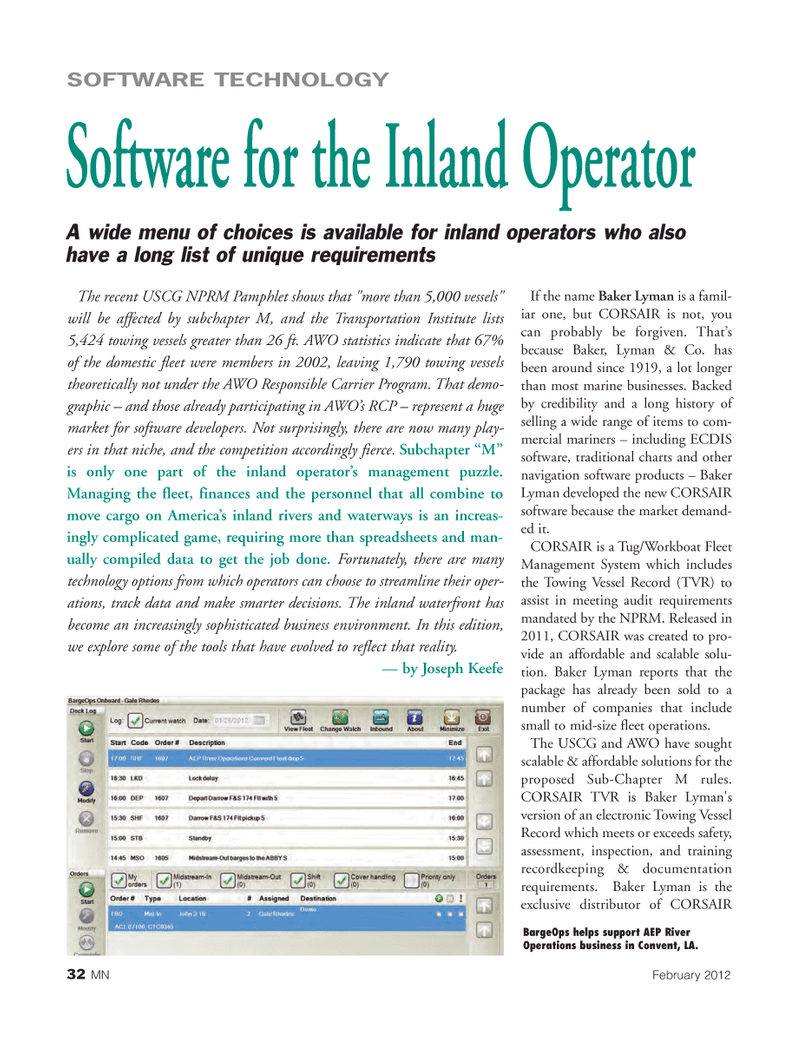
Page 32: of Marine News Magazine (February 2012)
Inland Bulk Transportation
Read this page in Pdf, Flash or Html5 edition of February 2012 Marine News Magazine
32MNFebruary 2012 If the name Baker Lyman is a famil-iar one, but CORSAIR is not, you can probably be forgiven. That?s because Baker, Lyman & Co. has been around since 1919, a lot longer than most marine businesses. Backed by credibility and a long history of selling a wide range of items to com-mercial mariners ? including ECDIS software, traditional charts and other navigation software products ? Baker Lyman developed the new CORSAIR software because the market demand- ed it.CORSAIR is a Tug/Workboat Fleet Management System which includes the Towing Vessel Record (TVR) to assist in meeting audit requirements mandated by the NPRM. Released in 2011, CORSAIR was created to pro- vide an affordable and scalable solu- tion. Baker Lyman reports that the package has already been sold to a number of companies that includesmall to mid-size fleet operations. The USCG and AWO have sought scalable & affordable solutions for the proposed Sub-Chapter M rules. CORSAIR TVR is Baker Lyman's version of an electronic Towing Vessel Record which meets or exceeds safety, assessment, inspection, and trainingrecordkeeping & documentation requirements. Baker Lyman is the exclusive distributor of CORSAIR Software for the Inland Operator A wide menu of choices is available for inland operators who alsohave a long list of unique requirementsSOFTWARE TECHNOLOGYBargeOps helps support AEP RiverOperations business in Convent, LA.The recent USCG NPRM Pamphlet shows that "more than 5,000 vessels" will be affected by subchapter M, and the Transportation Institute lists 5,424 towing vessels greater than 26 ft. AWO statistics indicate that 67% of the domestic fleet were members in 2002, leaving 1,790 towing vessels theoretically not under the AWO Responsible Carrier Program. That demo- graphic ? and those already participating in AWO?s RCP ? represent a huge market for software developers. Not surprisingly, there are now many play- ers in that niche, and the competition accordingly fierce. Subchapter ?M? is only one part of the inland operator?s management puzzle. Managing the fleet, finances and the personnel that all combine to move cargo on America?s inland rivers and waterways is an increas- ingly complicated game, requiring more than spreadsheets and man- ually compiled data to get the job done.Fortunately, there are many technology options from which operators can choose to streamline their oper- ations, track data and make smarter decisions. The inland waterfront has become an increasingly sophisticated business environment. In this edition, we explore some of the tools that have evolved to reflect that reality. ? by Joseph Keefe MN#2 (32-43):MN 2011 Layouts 2/3/2012 11:38 AM Page 32

 31
31

 33
33
